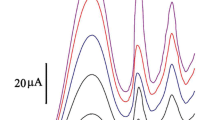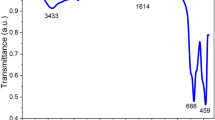Abstract
A novel electrochemical sensor based on multiwalled carbon nanotubes (MWCNTs) and 1-butyl-3-methylimidazolium hexafluorophosphate (BMIMPF6) hydrophobic ionic liquid for the rapid detection of Pb2+ and Cd2+ was developed. In this study, the BMIMPF6-MWCNTs composite, as well as BMIMPF6 and MWCNTs, were characterized using SEM. The electrochemical studies were performed using Cyclic Voltammetry (CV) and Electrochemical Impedance Spectroscopy (EIS). The BMIMPF6-MWCNTs/GCE exhibited excellent electrochemical activity. The effect of the pH value of 0.1 M NaAc/HAc buffer, deposition potential, and deposition time was investigated. Under the optimal conditions, the linear range for the modified sensors varies from 5 to 1850 µg L−1 for Pb2+ and 22 to 600 µg L−1 for Cd2+. The limit of detection (LOD) for Pb2+ and Cd2+ was 0.9 µg L−1 and 0.5 µg L−1, respectively, and the limit of quantification (LOQ) was 3 µg L−1 for Pb2+ and 1.7 µg L−1 for Cd2+. Moreover, this method showed excellent anti-interference performance, short analysis time, and practicability for determining Pb2+ and Cd2+. The electrochemical sensor was able to determine heavy metal ions in actual water samples without complex pretreatment, with acceptable recoveries from 98 to 110.8% for Pb2+ and 98.6 to 111.3% for Cd2+, demonstrating that the sensor based on BMIMPF6-MWCNTs/GCE can apply for Pb2+ and Cd2+ quantification.
Graphical abstract







Similar content being viewed by others
References
Kim K, Melough MM, Vance TM et al (2018) Dietary cadmium intake and sources in the US. Nutrients 11:2. https://doi.org/10.3390/nu11010002
Yang Q, Li Z, Lu X et al (2018) A review of soil heavy metal pollution from industrial and agricultural regions in China: Pollution and risk assessment. Sci Total Environ 642:690–700. https://doi.org/10.1016/j.scitotenv.2018.06.068
Yao Y, Wu H, Ping J (2019) Simultaneous determination of cd(II) and pb(II) ions in honey and milk samples using a single-walled carbon nanohorns modified screen-printed electrochemical sensor. Food Chem 274:8–15. https://doi.org/10.1016/j.foodchem.2018.08.110
Nourbakhsh A, Rahimnejad M, Asghary M, Younesi H (2022) Simultaneous electro-determination of trace copper, lead, and cadmium in tap water by using silver nanoparticles and graphene nanoplates as nanocomposite modified graphite electrode. Microchem J 175:107137. https://doi.org/10.1016/j.microc.2021.107137
Ayangbenro AS, Babalola OO (2017) A New Strategy for Heavy Metal Polluted environments: a review of Microbial Biosorbents. Int J Environ Res Public Health 14:94. https://doi.org/10.3390/ijerph14010094
Li XK, Ming QY, Cai R et al (2020) Biosorption of Cd2+ and Pb2+ from apple juice by the magnetic nanoparticles functionalized lactic acid bacteria cells. Food Control 109:106916. https://doi.org/10.1016/j.foodcont.2019.106916
El-Desoky HS, Beltagi AM, Ghoneim MM, El-Hadad AI (2022) The first utilization of graphene nano-sheets and synthesized Fe3O4 nanoparticles as a synergistic electrodeposition platform for simultaneous voltammetric determination of some toxic heavy metal ions in various real environmental water samples. Microchem J 175:106966. https://doi.org/10.1016/j.microc.2021.106966
Shaikh R, Kazi TG, Afridi HI, Akhtar A, Baig JA (2019) An environmental friendly enrichment method for microextraction of cadmium and lead in groundwater samples: impact on biological sample of children. Chemosphere 237:124444. https://doi.org/10.1016/j.chemosphere.2019.124444
Chowdhury S, Mazumder MAJ, Al-Attas O, Husain T (2016) Heavy metals in drinking water: occurrences, implications, and future needs in developing countries. Sci Total Environ 569–570:476–488. https://doi.org/10.1016/j.scitotenv.2016.06.166
Suárez-Oubiña C, Herbello-Hermelo P, Bermejo-Barrera P, Moreda-Piñeiro A (2022) Exploiting dynamic reaction cell technology for removal of spectral interferences in the assessment of Ag, Cu, Ti, and Zn by inductively coupled plasma mass spectrometry. Spectrochim Acta B 187:106330. https://doi.org/10.1016/j.sab.2021.106330
Fathabad AE, Shariatifar N, Moazzen M et al (2018) Determination of heavy metal content of processed fruit products from Tehran’s market using ICP- OES: a risk assessment study. Food Chem Toxicol 115:436–446. https://doi.org/10.1016/j.fct.2018.03.044
Souza JP, Cerveira C, Miceli TM et al (2020) Evaluation of sample preparation methods for cereal digestion for subsequent as, cd, hg and pb determination by AAS-based techniques. Food Chem 321:126715. https://doi.org/10.1016/j.foodchem.2020.126715
Chaikhan P, Udnan Y, Ampiah-Bonney RJ, Chaiyasith WC (2022) Fast sequential multi element analysis of lead and cadmium in canned food samples using effervescent tablet-assisted switchable solvent based liquid phase microextraction (EA-SS-LPME) coupled with high-resolution continuum source flame atomic absorption spectrometry (HR-CS-FAAS). Food Chem 375:131857. https://doi.org/10.1016/j.foodchem.2021.131857
Wang L, Peng X, Fu H et al (2019) Recent advances in the development of electrochemical aptasensors for detection of heavy metals in food. Biosens Bioelectron 147:111777. https://doi.org/10.1016/j.bios.2019.111777
Gumpu MB, Sethuraman S, Krishnan UM, Rayappan JBB (2015) A review on detection of heavy metal ions in water—an electrochemical approach. Sens Actuators B 213:515–533. https://doi.org/10.1016/j.snb.2015.02.122
Cobb SJ, Macpherson JV (2019) Enhancing Square Wave Voltammetry measurements via Electrochemical Analysis of the non-faradaic potential window. Anal Chem 91:7935–7942. https://doi.org/10.1021/acs.analchem.9b01857
Laborda E, González J, Molina Á (2014) Recent advances on the theory of pulse techniques: a mini review. Electrochem Commun 43:25–30. https://doi.org/10.1016/j.elecom.2014.03.004
Zhou J, Sun G, Pan J et al (2019) A nanocomposite consisting of ionic liquid-functionalized layered mg(II)/Al(III) double hydroxides for simultaneous electrochemical determination of cadmium(II), copper(II), mercury(II) and lead(II). Microchim Acta 186:767. https://doi.org/10.1007/s00604-019-3902-y
Mirceski V, Guziejewski D, Stojanov L, Gulaboski R (2019) Differential Square-Wave Voltammetry. Anal Chem 91:14904–14910. https://doi.org/10.1021/acs.analchem.9b03035
Khalifa Z, Hassan K, Abo Oura MF, Hathoot A, Azzem MA (2020) Individual and simultaneous voltammetric determination of Ultra-trace Environmental Contaminant Dihydroxybenzene isomers based on a Composite Electrode Sandwich-like structure. ACS Omega 5:18950–18957. https://doi.org/10.1021/acsomega.0c02228
Albalawi I, Hogan A, Alatawi H, Moore E (2021) A sensitive electrochemical analysis for cadmium and lead based on Nafion-Bismuth film in a water sample. Sens Bio-Sens Res 34:100454. https://doi.org/10.1016/j.sbsr.2021.100454
Alruwais RS, Adeosun WA, Marwani HM et al (2021) Novel aminosilane (APTES)-Grafted Polyaniline@Graphene oxide (PANI-GO) nanocomposite for Electrochemical Sensor. Polymers 13:2562. https://doi.org/10.3390/polym13152562
Kaur G, Kumar H, Singla M (2022) Diverse applications of ionic liquids: a comprehensive review. J Mol Liq 351:118556. https://doi.org/10.1016/j.molliq.2022.118556
RasulKhan B, Ponnaiah SK, Periakaruppan P, Venkatachalam G, Balasubramanian J (2020) A new CQDs/f-MWCNTs/GO nanocomposite electrode for arsenic (10 – 12 M) quantification in bore-well water and industrial effluents. New J Chem 44:18149–18156. https://doi.org/10.1039/d0nj04252h
Gholivand MB, Solgi M (2017) Sensitive warfarin sensor based on cobalt oxide nanoparticles electrodeposited at multi-walled carbon nanotubes modified glassy carbon electrode (CoxOyNPs/MWCNTs/GCE). Electrochim Acta 246:689–698. https://doi.org/10.1016/j.electacta.2017.06.105
Khosropour H, Saboohi M, Keramat M, Rezaei B, Ensafi AA (2023) Electrochemical molecularly imprinted polymer sensor for ultrasensitive indoxacarb detection by tin disulfide quantum dots/carbon nitride/multiwalled carbon nanotubes as a nanocomposite. Sens Actuators B 385:133652. https://doi.org/10.1016/j.snb.2023.133652
Karimi-Maleh H, Darabi R, Shabani-Nooshabadi M et al (2022) Determination of D&C Red 33 and Patent Blue V Azo dyes using an impressive electrochemical sensor based on carbon paste electrode modified with ZIF-8/g-C3N4/Co and ionic liquid in mouthwash and toothpaste as real samples. Food Chem Toxicol 162:112907. https://doi.org/10.1016/j.fct.2022.112907
Liao Y, Li Q, Yue Y, Shao SJ (2015) Selective electrochemical determination of trace level copper using a salicylaldehyde azine/MWCNTs/Nafion modified pyrolytic graphite electrode by the anodic stripping voltammetric method. RSC Adv 5:3232–3238. https://doi.org/10.1039/c4ra12342e
Qin XL, Guo WJ, Yu HJ, Zhao J, Pei MS (2015) A novel electrochemical aptasensor based on MWCNTs-BMIMPF6 and amino functionalized graphene nanocomposite films for determination of kanamycin. Anal Methods 7:5419–5427. https://doi.org/10.1039/c5ay00713e
Li G, Feng S, Yan L et al (2023) Direct electrochemical detection of Cu(II) ions in juice and tea beverage samples using MWCNTs-BMIMPF6-Nafion modified GCE electrodes. Food Chem 404:134609. https://doi.org/10.1016/j.foodchem.2022.134609
Li Y, He J, Niu Y, Yu C (2015) Ultrasensitive electrochemical biosensor based on reduced graphene oxide-tetraethylene pentamine-BMIMPF6 hybrids for the detection of alpha2,6-sialylated glycans in human serum. Biosens Bioelectron 74:953–959. https://doi.org/10.1016/j.bios.2015.07.073
Deshmukh MA, Celiesiute R, Ramanaviciene A, Shirsat MD, Ramanavicius A (2018) EDTA_PANI/SWCNTs nanocomposite modified electrode for electrochemical determination of copper (II), lead (II) and mercury (II) ions. Electrochim Acta 259:930–938. https://doi.org/10.1016/j.electacta.2017.10.131
Chen Y, Zhang D, Wang D et al (2019) A carbon-supported BiSn nanoparticles based novel sensor for sensitive electrochemical determination of cd (II) ions. Talanta 202:27–33. https://doi.org/10.1016/j.talanta.2019.04.066
Yu L, Zhang Q, Yang B et al (2018) Electrochemical sensor construction based on Nafion/calcium lignosulphonate functionalized porous graphene nanocomposite and its application for simultaneous detection of trace Pb2 + and Cd2+. Sens Actuators B 259:540–551. https://doi.org/10.1016/j.snb.2017.12.103
Li G, Belwal T, Luo Z et al (2021) Direct detection of Pb2+ and Cd2+ in juice and beverage samples using PDMS modified nanochannels electrochemical sensors. Food Chem 356:129632. https://doi.org/10.1016/j.foodchem.2021.129632
Velmurugan M, Chen S-M (2017) Synthesis and characterization of porous MnCo2O4 for Electrochemical Determination of Cadmium ions in Water samples. Sci Rep 7:653. https://doi.org/10.1038/s41598-017-00748-x
Ding Y, Wei F, Dong C et al (2021) UiO-66 based electrochemical sensor for simultaneous detection of cd(II) and pb(II). Inorg Chem Commun 131:108785. https://doi.org/10.1016/j.inoche.2021.108785
Malakootian M, Abolghasemi H, Mahmoudi-Moghaddam H (2020) A novel electrochemical sensor based on the modified carbon paste using Eu3+–doped NiO for simultaneous determination of pb (II) and cd (II) in food samples. J Electroanal Chem 876:114474. https://doi.org/10.1016/j.jelechem.2020.114474
Wang WJ, Lu XY, Kong FY et al (2022) A reduced graphene oxide supported Au-Bi bimetallic nanoparticles as an enhanced sensing platform for simultaneous voltammetric determination of pb (II) and cd (II). Microchem J 175:107078. https://doi.org/10.1016/j.microc.2021.107078
Acknowledgements
The authors gratefully acknowledge the financial support provided by the Guizhou Provincial Science and Technology Project (2020- [2018]-028); the Guizhou Provincial Education Department Project (KY2017-317); the Ecological Specialty Food Processing Innovation Team Project of Tongren University (CXTD [2020-21]); and the Guizhou Provincial First-class Professional Construction Project (YLBK-2022045).
Author information
Authors and Affiliations
Contributions
SF performed conceptualization, formal analysis, investigation, writing and preparation of original draft, and writing, reviewing, & editing of the manuscript. LY contributed to conceptualization and methodology. LLY contributed to conceptualization, investigation, and supervision methodology. MZ contributed to conceptualization and methodology. HX contributed to conceptualization, and methodology. YC, AY and ZC contributed to Validation, and Data curation. GL was involved in conceptualization, supervision, methodology, investigation, and writing and preparation of the original draft.
Corresponding authors
Ethics declarations
Conflict of interest
The authors declare that they have no known competing financial interests or personal relationships that could have appeared to influence the work reported in this paper.
Additional information
Publisher’s Note
Springer Nature remains neutral with regard to jurisdictional claims in published maps and institutional affiliations.
Rights and permissions
Springer Nature or its licensor (e.g. a society or other partner) holds exclusive rights to this article under a publishing agreement with the author(s) or other rightsholder(s); author self-archiving of the accepted manuscript version of this article is solely governed by the terms of such publishing agreement and applicable law.
About this article
Cite this article
Feng, S., Yang, L., Yan, L. et al. Rapid detection of heavy metal ions based on a novel BMIMPF6-MWCNTs/GCE sensor and square wave voltammetry in actual water samples. J Appl Electrochem (2024). https://doi.org/10.1007/s10800-023-02061-0
Received:
Accepted:
Published:
DOI: https://doi.org/10.1007/s10800-023-02061-0




